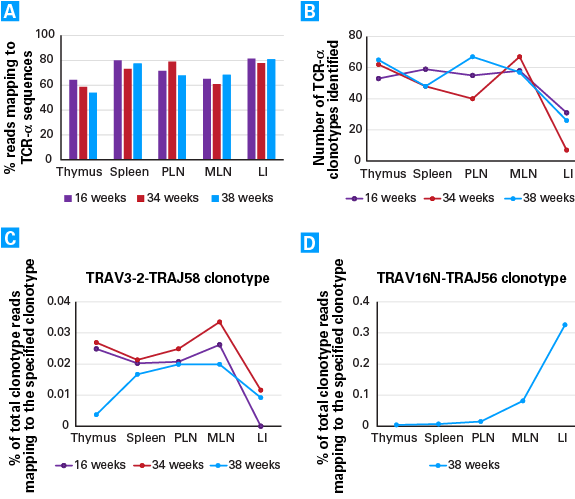SMARTer Mouse TCR a/b Profiling Kit—obtain full-length sequences of TCR-alpha and TCR-beta V(D)J variable regions

The SMARTer Mouse TCR a/b Profiling Kit provides a powerful new solution for those seeking to perform T-cell receptor (TCR) repertoire analysis using NGS. The kit employs a 5'-RACE-based approach to capture complete V(D)J variable regions of TCR transcripts, starting from as little as 10 ng to 500 ng of total RNA obtained from mouse spleen, thymus, or PBMCs, or from 1,000 to 10,000 purified T cells. As the name suggests, the kit can be used to generate data for both TCR-alpha and TCR-beta chain diversity, either in the same experiment or separately.
The SMARTer Mouse TCR a/b Profiling Kit provides a powerful new solution for those seeking to perform T-cell receptor (TCR) repertoire analysis using NGS. The kit employs a 5'-RACE-based approach to capture complete V(D)J variable regions of TCR transcripts, starting from as little as 10 ng to 500 ng of total RNA obtained from mouse spleen, thymus, or PBMCs, or from 1,000 to 10,000 purified T cells. As the name suggests, the kit can be used to generate data for both TCR-alpha and TCR-beta chain diversity, either in the same experiment or separately.
In contrast with TCR profiling methods that involve PCR multiplexing, each round of library amplification utilizes a single primer pair for each TCR subunit, thereby increasing efficiency and reducing the potential for primer-dimer formation. Multiplex PCR-based approaches are known to promote primer-associated, sequence-specific bias; this bias does not exist with our RACE-based approach, as all variable regions are primed from the same constant-region sequence. Using our ~4-hr protocol, libraries produced with the kit are indexed and ready for sequencing on Illumina platforms.
This kit leverages our proven SMART (Switching Mechanism at 5' End of RNA Template) technology along with LNA technology to amplify TCR mRNA sequences in an unbiased manner with remarkable sensitivity.
Overview
- Complete V(D)J sequence information—obtain full-length sequences for variable regions of TCR mRNA transcripts.
- TCR-alpha and TCR-beta—profile diversity for both TCR subunits, either in the same experiment or separately.
- No multiplex PCR required—amplify sequences for each TCR subunit with a single primer pair per reaction.
- Illumina-ready sequencing libraries—incorporate Illumina adapter and index sequences in a ligation-independent manner, and multiplex up to 96 libraries in a single flow-cell lane.
More Information
Applications
Mouse TCR repertoire analysis (TCR-alpha and TCR-beta subunits)
Additional product information
Please see the product's Certificate of Analysis for information about storage conditions, product components, and technical specifications. Please see the Kit Components List to determine kit components. Certificates of Analysis and Kit Components Lists are located under the Documents tab.
Takara Bio USA, Inc.
United States/Canada: +1.800.662.2566 • Asia Pacific: +1.650.919.7300 • Europe: +33.(0)1.3904.6880 • Japan: +81.(0)77.565.6999
FOR RESEARCH USE ONLY. NOT FOR USE IN DIAGNOSTIC PROCEDURES. © 2025 Takara Bio Inc. All Rights Reserved. All trademarks are the property of Takara Bio Inc. or its affiliate(s) in the U.S. and/or other countries or their respective owners. Certain trademarks may not be registered in all jurisdictions. Additional product, intellectual property, and restricted use information is available at takarabio.com.



